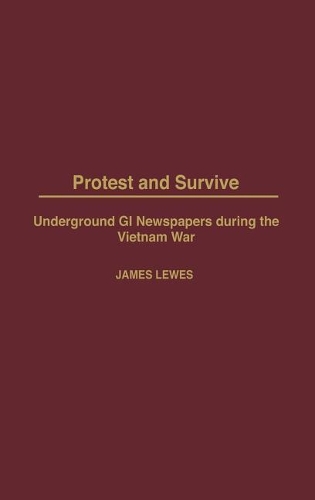
Protest and Survive: Underground GI Newspapers during the Vietnam War
(Hardback)
Publishing Details
Protest and Survive: Underground GI Newspapers during the Vietnam War
By (Author) James Lewes
Bloomsbury Publishing PLC
Praeger Publishers Inc
30th July 2003
United States
Classifications
General
Non Fiction
Warfare and defence
959.70431
Physical Properties
Hardback
256
Width 156mm, Height 235mm
567g
Description
Drawing from more than 120 newspapers, published between 1968 and 1970, this study explores the emergence of an anti-militarist subculture within the U.S. armed services. These activists took the position that individual GIs could best challenge their subordination by working in concert with like-minded servicemen through GI movement organizations whose behaviors and activities were then publicized in these underground newspapers. In examining this movement, Lewes focuses on their treatment of power and authority within the armed forces and how this mirrored the wider and more inclusive relations of power and authority in the United States. He argues that this opposition among servicemen was the primary motivation for the United States to withdraw from Vietnam. This first book length study of GI-published underground newspapers sheds light on the utility of alternative media for movements of social change, and provides information on how these movements are shaped by the environments in which they emerge. Lewes asserts that one cannot understand GI opposition as an extension of the civilian antiwar movement. Instead, it was the product of an embedded environment, whose inhabitants had been drafted or had enlisted to avoid the draft. They came from cities and small towns whose populations were often polarized between those who wholeheartedly supported the war and those who became progressively more critical of the need for Americans to be involved in Vietnam.
Reviews
[r]ecalls and analyzes the sudden expansion of the antiwar underground GI press in the late 1960s.-CJR Book reports
[L]ewes demonstrates that the journalism of dissent linked civilian and GI antiwar protesters, empowered enlistees by breaking down their isolation, and filled a vacuum created by the mainstream media. Lewes enriches the book with a collection of gritty cartoons from the era and a time line of dissent within military ranks from 1965 though 1970. Highly recommended. Lower/upper-division undergraduates and graduate students.-Choice
"recalls and analyzes the sudden expansion of the antiwar underground GI press in the late 1960s."-CJR Book reports
"Lewes demonstrates that the journalism of dissent linked civilian and GI antiwar protesters, empowered enlistees by breaking down their isolation, and filled a vacuum created by the mainstream media. Lewes enriches the book with a collection of gritty cartoons from the era and a time line of dissent within military ranks from 1965 though 1970. Highly recommended. Lower/upper-division undergraduates and graduate students."-Choice
"[r]ecalls and analyzes the sudden expansion of the antiwar underground GI press in the late 1960s."-CJR Book reports
"[L]ewes demonstrates that the journalism of dissent linked civilian and GI antiwar protesters, empowered enlistees by breaking down their isolation, and filled a vacuum created by the mainstream media. Lewes enriches the book with a collection of gritty cartoons from the era and a time line of dissent within military ranks from 1965 though 1970. Highly recommended. Lower/upper-division undergraduates and graduate students."-Choice
Author Bio
JAMES LEWES received his doctorate in Journalism and Mass Communications from the University of Iowa.
